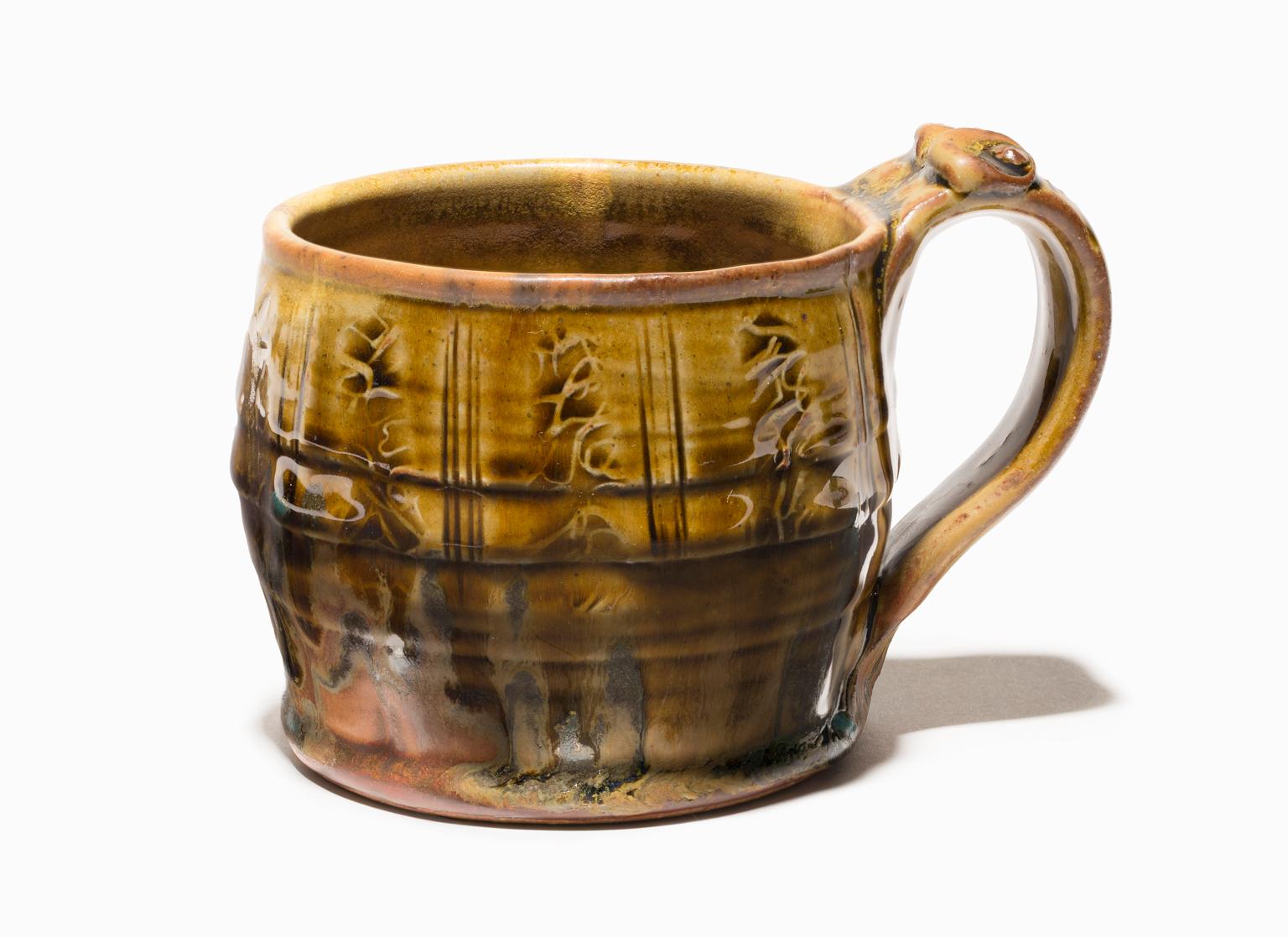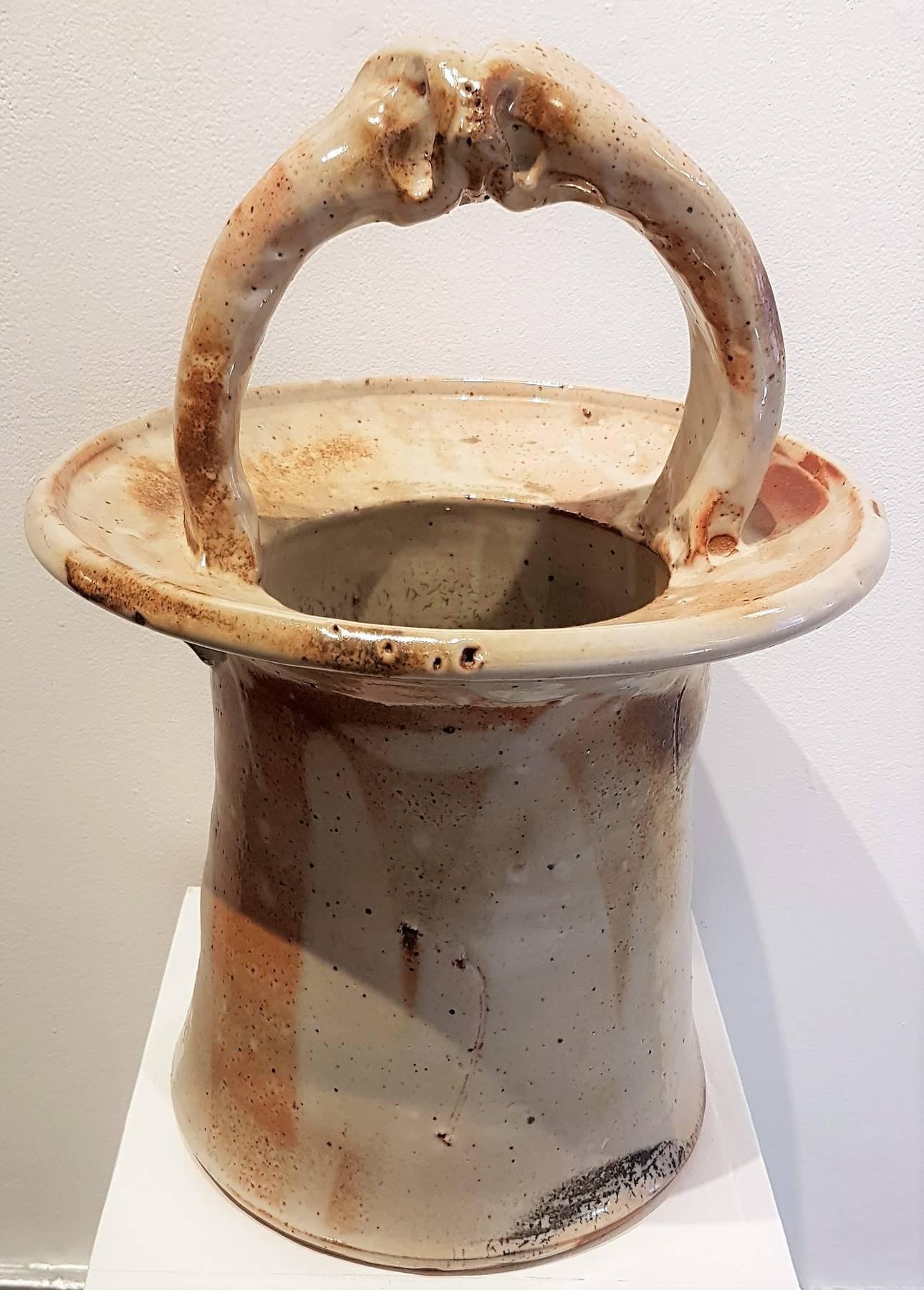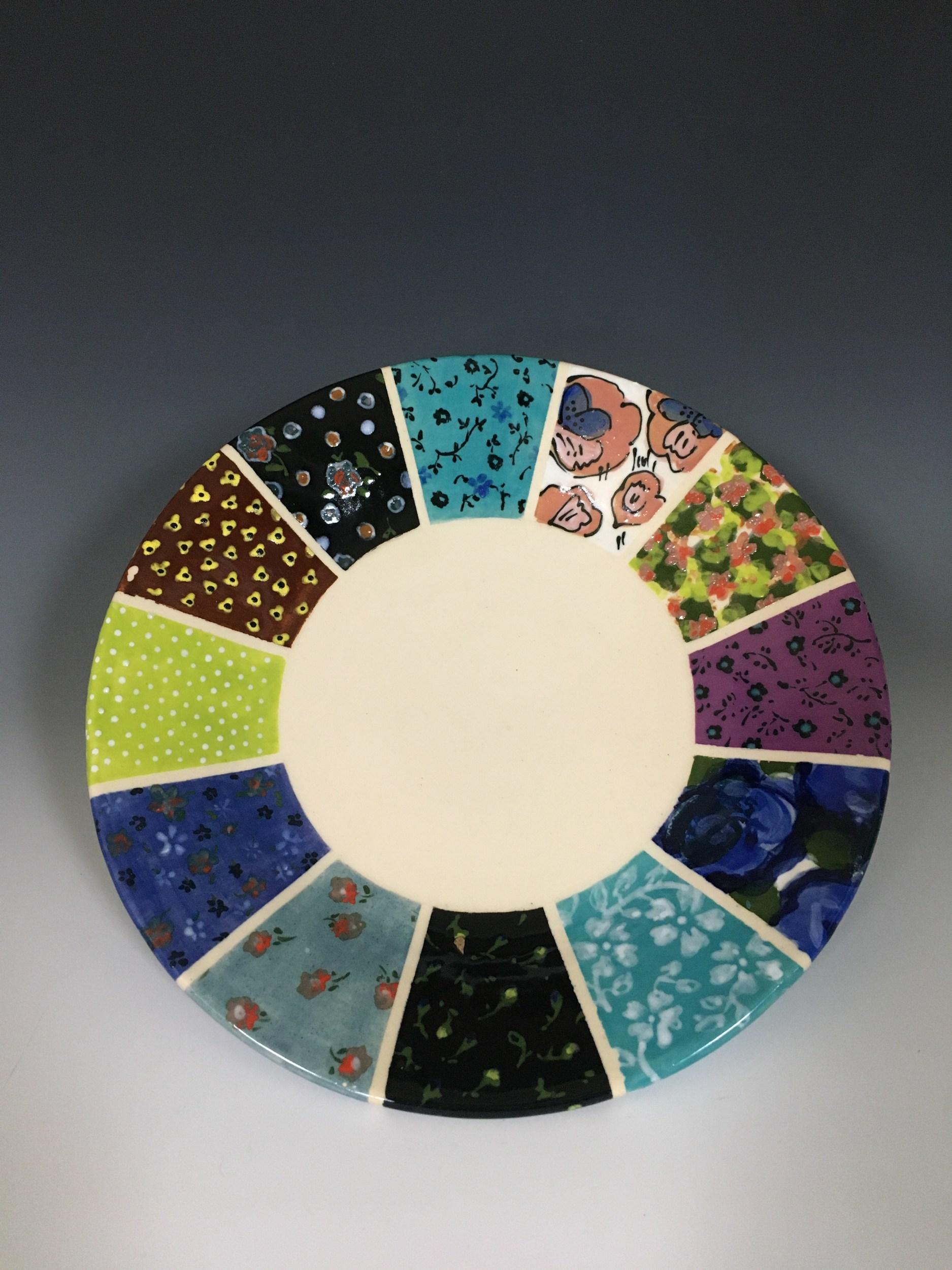Items Similar to "Untitled" Ceramic Vase with Etched Figures, Green Glaze, Signed on Bottom
Want more images or videos?
Request additional images or videos from the seller
1 of 8
Murray Douglas"Untitled" Ceramic Vase with Etched Figures, Green Glaze, Signed on Bottom
About the Item
SALE ONE WEEK ONLY
Douglas’s etched ceramic vase in a rich earthy green glaze expresses the Mid-Century Modern style of simplicity of lines, forms and color. Despite its formal shape and subdued color, upon closer inspection can be seen exciting activity between nude figures chasing each other - around and around no one caught and no one stopping adding a bit of humor to an already physically satisfying piece.
Murray Douglas lived in Detroit, Bloomfield Hills and Royal Oak before retiring and moving to California. He started his career as a ceramicist working as an assistant to Mary Chase Stratton at Pewabic Pottery located in Detroit, Michigan.
Professor Douglas began his professional career as an art teacher at Brookside School at Cranbrook in Bloomfield Hills, where he taught from 1936-1950 except for two years of Army service in Europe during World War II. After the war he taught part-time in Wayne State University’s art education department and was offered a full-time professorship in 1950. He later was named department chairman. Through the years he advised hundreds of graduate students who now teach art throughout Michigan while teaching ceramics and graduate seminars. He retired in 1980.
Retired WSU Professor Fred Attebury, who taught art education from 1968 to1994, quoted Douglas as often saying that Wayne State had earned its reputation as a fine teaching institution with great interest in its students. "Douglas continued this fine tradition," Attebury said.
Professor Douglas received a bachelor's degree from Wayne in 1936, a master's degree from Ohio State University in 1940 and a doctorate from Ohio State in 1956.
He was listed in Who's Who in America, exhibited his ceramics work nationally and received awards from the National Ceramics Show and the Michigan Craftsmen Show. He also received one of Wayne State's first Arts Achievement Awards in 1975.
He was active in the national and Michigan Art Education Associations,¬ Michigan Potters' Association and the American Association of University Professors.
- Creator:Murray Douglas (1916 - 1997, American)
- Dimensions:Height: 9 in (22.86 cm)Diameter: 6 in (15.24 cm)
- Medium:
- Movement & Style:
- Period:
- Condition:
- Gallery Location:Detroit, MI
- Reference Number:1stDibs: LU128618361972
About the Seller
5.0
Vetted Seller
These experienced sellers undergo a comprehensive evaluation by our team of in-house experts.
Established in 2014
1stDibs seller since 2019
95 sales on 1stDibs
Typical response time: 4 hours
- ShippingRetrieving quote...Ships From: Detroit, MI
- Return PolicyA return for this item may be initiated within 14 days of delivery.
More From This SellerView All
- John Glick Plum Tree Pottery , Stoneware Mug, Deep Earth Tones, GlazedLocated in Detroit, MI“Untitled” ceramic, is an example of the kind of work by which John Glick became so famous. He was seduced by the effects of the reduction kiln, which decreased the levels of oxygen during firing, inducing the flame to pull oxygen out of the clay and glazes changing the colors of the glazes depending on their iron and copper content. In this way he achieved the rich gradients of ochre and umber and variations in stippling and opacity. This piece is signed on the bottom and can be found on page 129, plate #236 in “John Glick: A Legacy in Clay.” John was an American Abstract Expressionist ceramicist born in Detroit, MI. Though open to artistic experimentation, Glick was most influenced by the styles and aesthetics of Asian pottery—an inspiration that shows in his use of decorative patterns and glaze choices. He has said that he is attracted to simplicity, as well as complexity: my work continually reflects my re-examination that these two poles can coexist… or not, in a given series. Glick also took influences from master potters of Japan, notably Shoji Hamada and Kanjrio Kawai, blending their gestural embellishments of simple forms with attitudes of Abstract Expressionism. He was particularly drown to the work of Helen Frankenthaler whose soak-stain style resonated with Glick’s multi-layered glaze surfaces, which juxtaposed veils of atmospheric color with gestural marks and pattern. He spent countless hours developing and making his own tools in order to achieve previously unseen results in his work with clay and glaze. Glick’s “Plum Tree Pottery...Category
Late 20th Century American Modern More Art
MaterialsStoneware, Glaze
- John Glick Plum Street Pottery Reduction Fired Shino Glaze Cup Published in BookLocated in Detroit, MI“Untitled” ceramic, is an example of the kind of work by which John Glick became so famous. He was seduced by the effects of the reduction kiln, which decreased the levels of oxygen during firing, inducing the flame to pull oxygen out of the clay and glazes changing the colors of the glazes depending on their iron and copper content. In this way he achieved the rich gradients of ochre and umber and variations in stippling and opacity. This piece is signed on the bottom and can be found on page 92, plate #125 in “John Glick: A Legacy in Clay.” John was an American Abstract Expressionist ceramicist born in Detroit, MI. Though open to artistic experimentation, Glick was most influenced by the styles and aesthetics of Asian pottery—an inspiration that shows in his use of decorative patterns and glaze choices. He has said that he is attracted to simplicity, as well as complexity: my work continually reflects my re-examination that these two poles can coexist… or not, in a given series. Glick also took influences from master potters of Japan, notably Shoji Hamada and Kanjrio Kawai, blending their gestural embellishments of simple forms with attitudes of Abstract Expressionism. He was particularly drown to the work of Helen Frankenthaler whose soak-stain style resonated with Glick’s multi-layered glaze surfaces, which juxtaposed veils of atmospheric color with gestural marks and pattern. He spent countless hours developing and making his own tools in order to achieve previously unseen results in his work with clay and glaze. Glick’s “Plum Tree Pottery...Category
1990s American Modern More Art
MaterialsStoneware, Glaze
- John Glick Plum Street Pottery Glazed Bowl Reduction FiredLocated in Detroit, MI"Untitled" is a stoneware piece with the decorative layer of the rich toned glazes and markings that John was so well-known for. Each piece that John produced was unique. The lip on this piece is slightly scalloped and the shape is removed from the boring circular to mimic a gentle geometric design. He was seduced by the effects of the reduction kiln, which decreased the levels of oxygen during firing, inducing the flame to pull oxygen out of the clay and glazes changing the colors of the glazes depending on their iron and copper content. In this way he achieved the rich gradients of ochre and umber and variations in stippling and opacity. This piece is signed and stamped on the bottom. John was an American Abstract Expressionist ceramicist born in Detroit, MI. Though open to artistic experimentation, Glick was most influenced by the styles and aesthetics of Asian pottery—an inspiration that shows in his use of decorative patterns and glaze choices. He has said that he is attracted to simplicity, as well as complexity: my work continually reflects my re-examination that these two poles can coexist… or not, in a given series. Glick also took influences from master potters of Japan, notably Shoji Hamada and Kanjrio Kawai, blending their gestural embellishments of simple forms with attitudes of Abstract Expressionism. He was particularly drown to the work of Helen Frankenthaler whose soak-stain style resonated with Glick’s multi-layered glaze surfaces, which juxtaposed veils of atmospheric color with gestural marks and pattern. He spent countless hours developing and making his own tools in order to achieve previously unseen results in his work with clay and glaze. Glick’s “Plum Tree Pottery...Category
1970s American Modern Abstract Sculptures
MaterialsStoneware, Glaze
- Magnificent John Glick Plum Street Pottery "Scalloped Box" Glazed StonewareLocated in Detroit, MIThis magnificent "Scalloped Box" is a stoneware piece with decorative layers of rich toned glazes and markings that John was so well-known for. He was, also, known for the undulating lip lines on his exquisite boxes that fit together like a puzzle. Each piece that John produced was unique. He was seduced by the effects of the reduction kiln, which decreased the levels of oxygen during firing, inducing the flame to pull oxygen out of the clay and glazes thereby changing the colors of the glazes depending on their iron and copper content. In this way he achieved the rich gradients of ochre and umber and variations in stippling and opacity. This piece is signed and stamped on the bottom. John was an American Abstract Expressionist ceramicist born in Detroit, MI. Though open to artistic experimentation, Glick was most influenced by the styles and aesthetics of Asian pottery—an inspiration that shows in his use of decorative patterns and glaze choices. He has said that he is attracted to simplicity, as well as complexity: my work continually reflects my re-examination that these two poles can coexist… or not, in a given series. Glick also took influences from master potters of Japan, notably Shoji Hamada and Kanjrio Kawai, blending their gestural embellishments of simple forms with attitudes of Abstract Expressionism. He was particularly drown to the work of Helen Frankenthaler whose soak-stain style resonated with Glick’s multi-layered glaze surfaces, which juxtaposed veils of atmospheric color with gestural marks and pattern. He spent countless hours developing and making his own tools in order to achieve previously unseen results in his work with clay and glaze. Glick’s “Plum Tree Pottery...Category
Late 20th Century American Modern Abstract Sculptures
MaterialsStoneware, Glaze
- Breathtaking John Glick "Scalloped Basket" Glazed Stoneware Reduction FiredLocated in Detroit, MI"Scalloped Basket" is a stoneware piece with the decorative layer of the rich toned glazes and markings that John was so well-known for. He was, also, known for the undulating lip lines on his exquisite pieces. The basket portion is shaped with gentle curves and a sculptural handle. Each piece that John produced was unique. He was seduced by the effects of the reduction kiln, which decreased the levels of oxygen during firing, inducing the flame to pull oxygen out of the clay and glazes changing the colors of the glazes depending on their iron and copper content. In this way he achieved the rich gradients of ochre and umber and variations in stippling and opacity. This particular "basket" also has the cool blues and grays that contrast with the umber. It is signed and stamped on the bottom. John was an American Abstract Expressionist ceramicist born in Detroit, MI. Though open to artistic experimentation, Glick was most influenced by the styles and aesthetics of Asian pottery—an inspiration that shows in his use of decorative patterns and glaze choices. He has said that he is attracted to simplicity, as well as complexity: my work continually reflects my re-examination that these two poles can coexist… or not, in a given series. Glick also took influences from master potters of Japan, notably Shoji Hamada and Kanjrio Kawai, blending their gestural embellishments of simple forms with attitudes of Abstract Expressionism. He was particularly drown to the work of Helen Frankenthaler whose soak-stain style resonated with Glick’s multi-layered glaze surfaces, which juxtaposed veils of atmospheric color with gestural marks and pattern. He spent countless hours developing and making his own tools in order to achieve previously unseen results in his work with clay and glaze. Glick’s “Plum Tree Pottery...Category
1970s American Modern Abstract Sculptures
MaterialsStoneware, Glaze
- Aldo Londi Vase Abstract "Glass Fused Ceramic Vase"Located in Detroit, MISALE ONE WEEK ONLY "Glass Fused Ceramic Vase" is vintage Mid-Century Modern. This handsome vase has an elongated neck with a white glass-fused inlay porti...Category
Mid-20th Century American Modern More Art
MaterialsCeramic, Glass
You May Also Like
- Particle VIII (Eight)By Brady McLearenLocated in Kansas City, MOParticle VIII (Eight) Materials: Ceramic, glaze Year: 2016 The formal languages and frequencies that we find in the natural existence of the universe inform and inspire the investig...Category
2010s American Modern More Art
MaterialsCeramic, Glaze
- Basket with handleBy Ken FergusonLocated in Kansas City, MOKen Ferguson Basket with handle Material: Stoneware, glaze Year: Circa 1980 Size: 18 x 13 inches Stamped Kenneth Richard Ferguson was an American c...Category
1980s American Modern More Art
MaterialsStoneware, Glaze
- Brown 10 Petal PlateBy Rachel Hubbard KlineLocated in Kansas City, MORachel Hubbard Kline Brown 10 Petal Plate Medium: Stoneware, underglaze, glaze Year: 2021 Size: 1 1/4" x 7 3/4" x 7 3/4" Description: Wheel-thrown plate wi...Category
2010s American Modern More Art
MaterialsStoneware, Glaze, Underglaze
- Twelve Pattern PlateBy Rachel Hubbard KlineLocated in Kansas City, MORachel Hubbard Kline Twelve Pattern Plate Medium: Stoneware, underglaze, glaze Year: 2021 Size: 1 1/2" x 8" x 8" Description: Wheel-thrown plate with hand-painted textile pattern -...Category
2010s American Modern More Art
MaterialsGlaze, Underglaze, Stoneware
- Museum Quality Shino platter by Warren MacKenzieBy Warren MacKenzieLocated in Morton Grove, ILWarren MacKenzie Finger Swiped Shino Platter approx 3.5 x 19.75 x 19.75" Stoneware and glaze date unknown Possibly stamped under the glaze but cannot see the MA mark.Category
1990s American Modern More Art
MaterialsStoneware, Glaze
- Plate with Ram (Untitled)By Henry Varnum PoorLocated in Los Angeles, CA(Note: This work is part of our exhibition Connected by Creativity: WPA Era Works from the Collection of Leata and Edward Beatty Rowan) Glazed and incised ceramic, 8 ½ inches diamet...Category
1920s American Modern More Art
MaterialsCeramic
Recently Viewed
View AllMore Ways To Browse
Green Bottom
Michigan Art
Ohio Signed
Ohio State
Vintage Army Signs
Vintage Army Sign
Glazed Oak
Vintage American Express Sign
Vintage Ceramic Figures
American Potter
Live Oak Art
Douglas Brown
Vintage Green Art Pottery
Royal Oak Vintage
Retro Royal Oak
Ceramic Ohio
Vintage California Pottery Vase
Green Vase With Figures




